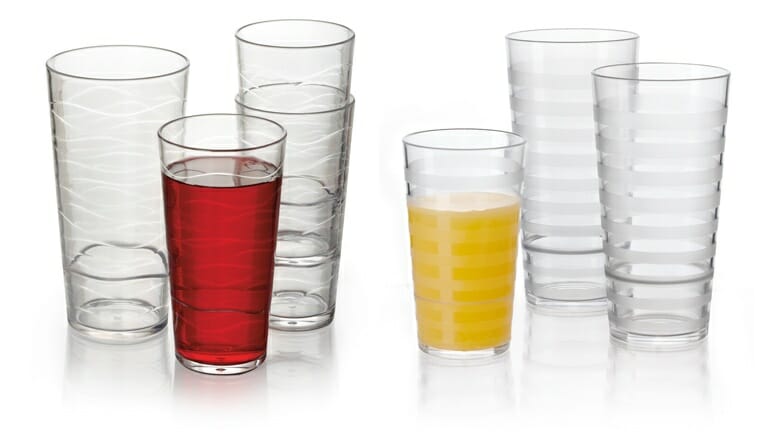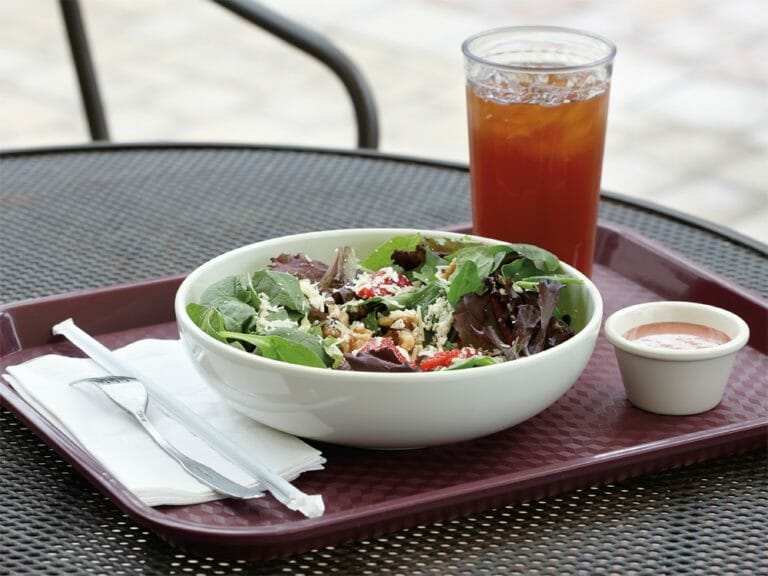PC vs SAN Plastic Tumblers: What’s the Difference?
Plastic tumblers are a popular drinkware option in foodservice because of the operational benefits of durability, which is a cost-saver, and because there are plenty of new designs to elevate tabletop presentation. We’re going to unpack two common types of plastic used to manufacture tumblers, PC and SAN (polycarbonate and styrene-acrylonitrile, respectively), to help you understand their differences and similarities so that you can find the right material for your operation.
 Pictured: SAN Plastic Streamª Tumblers and SAN Plastic Orbisª Tumblers
Pictured: SAN Plastic Streamª Tumblers and SAN Plastic Orbisª Tumblers
About PC and SAN Plastic Materials
We won’t bore you with a chemistry lesson, we’ll just give you a quick overview of these materials. They’re both forms of plastic, but each material composition has strengths and weaknesses regarding their manufacturing capabilities, and their appearance and durability benefits.
Similarities Between PC and SAN Plastic Materials
Generally, these two materials have more similarities than differences. They’re both impact-resistant, dishwasher safe, customizable, and have good clarity, but are not microwavable.
The manufacturing of these materials results in products that look similar to glassware. Unlike glassware, neither will break or shatter during the dishwashing process.
Both materials have the capability of being shaped into tall glasses commonly used in restaurants for water, fountain drink, and iced tea service. They can be customized with logos, designs, and custom colors.
Both materials are available in a variety of sizes and on-trend, modern designs and colors.
Differences Between PC and SAN Plastic Materials
The differences in durability, clarity, and handling vary between these two materials and will have different impacts on your operation depending on what your needs are.
Both PC and SAN are durable, but in different ways. In a study conducted by Eastman Kodak, SAN and PC tumblers were washed in a commercial dishwasher 1,000 times. PC tumblers showed obvious signs of wear after only 100 washes, while SAN tumblers withstood all 1,000 wash cycles. This is because SAN plastic has a higher chemical resistance to dish detergent than PC plastic.
Pro Tip If you’re a high-volume operation, it’s important to know that PC drinkware may need to be replaced at 10x the rate of SAN tumblers.
On the other hand, SAN tumblers may crack when dropped on a hard surface, while PC tumblers tend to be more impact-resistant.
The difference between these two materials yields different kinds of durability, but the design of the tumbler can also have an affect on durability. That’s why buying your plastic tumblers from reputable manufacturers who are experts in foodservice plastic is important. They have trained design engineers who work to minimize weak points in product designs, improving the overall performance of your tumbler.
Another difference is that PC tends to be more clear than SAN, and SAN can sometimes have a faint blue or yellow tint. There are different tiers of PC and SAN, so clarity outcomes of the manufacturing process can vary slightly within the different tiers and the raw materials used.
Some have heard concerns about BPA as a carcinogen. PC tumblers are not BPA-free. However, the FDA says “…that BPA is safe at the current levels occurring in [food contact applications].” We understand that you may prefer, or be required to use a BPA-free product. If that’s the case, then SAN tumblers are your best choice between the two materials.
Why Buy One Plastic Tumbler Over the Other?
Plastic tumblers are favored by most foodservice operations because of their tried-and-true durability, which minimizes liability concerns and replacement rates while saving you money.
If you’re a high-volume operation, you may benefit from choosing SAN plastic drinkware due to its superior chemical resistance to dish detergents, which increases its longevity.
If BPA is a concern for your operation, then SAN is your choice between these materials because BPA is an inherent part of PC manufacturing and cannot be removed from the material. However, if you prefer to have a bit more clarity in your plastic drinkware, PC tumblers are a good choice.
Once you find the right fit, be sure to follow the recommended care and maintenance to get the longest service life possible out of your purchase, regardless of the plastic material you choose.
We hope this provides an easy-to-follow overview of your options so you can find the best plastic tumblers for your operation. Another topic you may be interested in is the difference between commercial-grade and retail melamine dinnerware.








